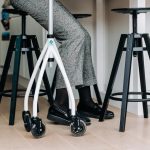If you’ve been standing for a long time, watch for early signs of poor circulation. You might experience numbness or tingling in your feet and legs, swelling in your ankles, or even cold limbs. These symptoms indicate your body’s struggle to maintain healthy blood flow. It’s essential to recognize these issues early to prevent complications. To learn more about managing circulation while standing, keep going with the information that follows.
Table of Contents
Key Takeaways
- Swelling in Legs/Ankles: Prolonged standing can cause blood to pool, leading to noticeable puffiness in lower extremities.
- Numbness or Tingling: Reduced blood flow may result in sensations of numbness or tingling in the legs and feet.
- Fatigue and Tiredness: Standing for extended periods can lead to increased fatigue and decreased productivity.
- Cold Limbs: Legs or feet may feel cooler than the rest of the body, indicating poor circulation.
- Varicose Veins: Development of swollen, painful veins can occur over time due to ongoing pressure from standing.
Understanding Poor Circulation
When you think about circulation, you might picture blood flowing smoothly through your veins, delivering oxygen and nutrients to your body.
Poor circulation occurs when this flow is restricted, leading to a lack of essential nutrients reaching your tissues. Several factors can contribute to this condition, such as narrowed blood vessels, blood clots, or even prolonged periods of standing.
You may not always notice the impact right away, but over time, it can affect your overall health. Maintaining good circulation is important for energy levels, organ function, and even your skin’s appearance.
Common Symptoms of Poor Circulation
Recognizing the common symptoms of poor circulation can help you take action before more serious health issues arise. You may experience numbness or tingling in your extremities, especially in your hands and feet. Swelling in your legs or ankles can also signal circulation issues. Coldness in your limbs, particularly when compared to the rest of your body, is another red flag. Additionally, you might notice skin discoloration or changes in temperature.
| Symptom | Description | Action to Take |
|---|---|---|
| Numbness/Tingling | Sensation loss in hands/feet | Move around, stretch |
| Swelling | Puffiness in legs/ankles | Elevate legs |
| Cold Limbs | Noticeably cooler than the rest of body | Keep warm |
| Skin Discoloration | Unusual color changes in skin | Consult a doctor |
| Temperature Changes | Variations in warmth of limbs | Monitor symptoms |
The Impact of Prolonged Standing
Prolonged standing can greatly strain your circulatory system, leading to a range of discomforts and health issues.
When you remain on your feet for extended periods, you might experience:
- Swelling: Your legs and feet may swell due to blood pooling.
- Fatigue: You could feel more tired than usual, impacting your overall productivity.
- Varicose veins: Standing for long stretches can contribute to the development of these swollen veins, which can be painful.
- Numbness or tingling: Reduced blood flow may cause sensations of numbness or tingling in your legs and feet.
Recognizing these impacts early can help you make adjustments to your routine, ensuring you maintain better circulatory health.
Risk Factors for Poor Circulation
When it comes to poor circulation, your lifestyle choices play an essential role.
A sedentary lifestyle can greatly hinder blood flow, while the type of footwear you wear can either support or restrict circulation in your feet.
Identifying these risk factors can help you take proactive steps to improve your overall vascular health.
Sedentary Lifestyle Effects
A sedentary lifestyle can quietly undermine your circulatory health, as regular movement is essential for maintaining blood flow and oxygen delivery throughout your body.
When you spend long hours sitting or inactive, several issues can arise:
- Reduced Blood Flow: Lack of movement slows down circulation, making it harder for your body to deliver nutrients.
- Increased Risk of Blood Clots: Extended periods of sitting can lead to the formation of clots, especially in the legs.
- Weakening of Blood Vessels: Without regular exercise, your blood vessels can lose elasticity, impairing overall circulation.
- Higher Blood Pressure: A sedentary lifestyle often correlates with elevated blood pressure, putting extra strain on your heart and circulatory system.
Staying active is vital to counter these effects and promote better circulation.
Footwear Impact on Circulation
Choosing the right footwear is essential for maintaining healthy circulation, as ill-fitting shoes can lead to various issues. When your shoes are too tight, they can compress blood vessels, restricting blood flow to your feet. This can cause numbness, tingling, or even pain after standing for long periods.
On the other hand, overly loose shoes can lead to instability and increased friction, which can cause blisters and further circulation problems. Opt for shoes that provide proper arch support and cushioning, allowing your feet to breathe.
Tips for Improving Circulation While Standing
Many people don’t realize that standing for long periods can hinder circulation.
Fortunately, you can take steps to improve blood flow while you’re on your feet. Here are some effective tips:
- Shift Your Weight: Alternate your weight from one foot to the other to reduce pressure on your legs.
- Take Short Breaks: Whenever possible, sit down or walk around for a few minutes to stimulate circulation.
- Stretch Regularly: Incorporate simple stretches, like calf raises or ankle circles, to keep your blood flowing.
- Wear Compression Socks: These can help maintain circulation and reduce swelling in your legs.
When to Seek Medical Advice
If you’re experiencing persistent leg discomfort, swelling, or inflammation, it’s time to pay attention.
Numbness or tingling that doesn’t go away can also signal issues with your circulation.
Don’t hesitate to seek medical advice if these symptoms arise; your health is worth it.
Persistent Leg Discomfort
While you might dismiss occasional leg discomfort as a normal part of life, persistent pain can signal underlying issues that shouldn’t be ignored.
If you’re experiencing ongoing leg discomfort, it’s essential to pay attention and consider seeking medical advice.
Here are some warning signs to watch for:
- Increased pain: If the discomfort intensifies over time or doesn’t improve with rest.
- Numbness or tingling: Experiencing unusual sensations that don’t go away can indicate nerve issues.
- Difficulty walking: Struggling to move your legs or feeling unstable while walking should be addressed.
- Changes in color: If your legs become discolored, such as turning pale or blue, it’s vital to consult a healthcare professional.
Taking prompt action can help prevent further complications.
Swelling and Inflammation
Swelling and inflammation in your legs can be alarming, especially if it happens suddenly or without an obvious cause. It’s essential to pay attention to these symptoms, as they might indicate poor circulation or other underlying health issues. If you notice persistent swelling, redness, or warmth in your legs, seek medical advice.
| Symptoms to Watch For | When to Seek Help |
|---|---|
| Sudden swelling | Immediately |
| Pain or tenderness | Within a few days |
| Swelling that doesn’t improve | After a week |
Ignoring these signs can lead to more serious complications, so it’s better to be safe and consult your healthcare provider for a thorough evaluation.
Numbness or Tingling
Numbness or tingling in your legs can signal issues with circulation, especially after experiencing swelling or inflammation.
If you notice these sensations, it’s important to pay attention to their frequency and intensity. Seek medical advice if you experience any of the following:
- Persistent Symptoms: Numbness or tingling lasts longer than a few minutes.
- Severe Pain: Accompanied by sharp or intense pain in your legs.
- Weakness: Difficulty walking or moving your legs normally.
- Color Changes: Your skin turns pale, bluish, or feels unusually cold.
Recognizing these signs early can help prevent serious complications.
Don’t hesitate to consult a healthcare professional for proper evaluation and guidance.
Frequently Asked Questions
Can Poor Circulation Cause Long-Term Damage to My Legs?
Imagine your legs feeling like a wilting flower; poor circulation can indeed cause long-term damage. If you ignore the signs, you risk chronic pain, swelling, and even mobility issues. Don’t let that happen to you!
Are Certain Foot Positions Better for Circulation While Standing?
While standing, shift your weight between feet and slightly bend your knees. Keeping your feet flat and avoiding locking your knees can improve circulation. Try to move periodically to promote better blood flow and reduce discomfort.
How Does Hydration Affect Circulation During Prolonged Standing?
You might think hydration doesn’t matter much while standing, but it really does. Staying hydrated improves blood flow, reduces fatigue, and helps prevent discomfort. So, keep that water bottle handy to support your circulation!
Can Poor Circulation Lead to Varicose Veins?
Yes, poor circulation can lead to varicose veins. When blood flow becomes restricted, pressure builds in your veins, causing them to enlarge. Staying active and elevating your legs can help prevent this condition.
Is There a Relationship Between Poor Circulation and Skin Color Changes?
Isn’t it fascinating how poor circulation can turn your skin a lovely shade of blue or purple? When your blood flow’s restricted, you might notice these color changes, signaling that something’s definitely off with your circulation.




